This picture shows the parts of a car engine, and I will explain each part and its function. Every driver must know his car well, so that if, God forbid, he encounters a problem, he can evaluate the cause, or at least be familiar with the work of each part of the engine and its characteristics. Here I will explain. The important parts that the driver must know and may be asked about during the practical test to drive a car. You must also know or memorize the shape of the containers and each one of them for any purpose, so that if you are asked about them in the practical test, you can answer.
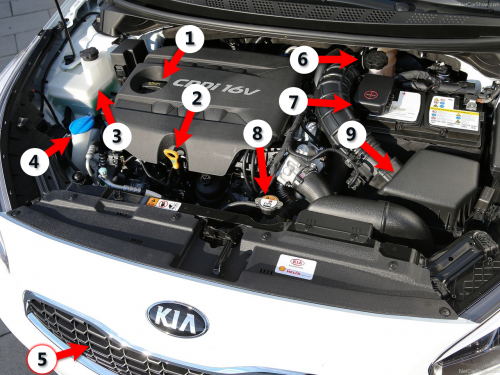
Explanation of point number 1
See the picture above
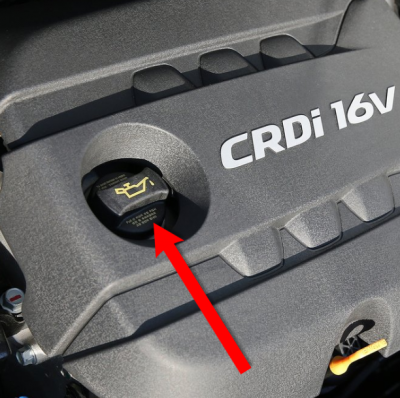
Engine oil It is an oil used to lubricate internal combustion engines. The primary purpose is to lubricate the moving parts. It also cleans, prevents corrosion, improves performance, and cools the engine by removing heat from the moving parts. Few other components are added to the engine oil that make it withstand high pressures. Oil consists of hydrocarbons, organic compounds consisting entirely of carbon and hydrogen.
Indicators indicating damage to the engine oil
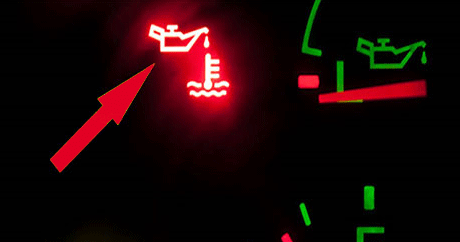
Oil warning light illuminated: The illumination of the oil warning light on the dashboard is one of the strongest indicators of a problem with the oil pressure in the engine. If this light appears, you must stop immediately and check the oil.
Oil colour: It is common knowledge that the color of basic engine oil is brown or light honey, but as time passes and the oil is not changed for long periods, the color of the oil turns dark black as a result of it being filled with impurities and being exposed to burning, which indicates damage.
Smoke coming out of the exhaust: If the car driver notices white smoke emerging from the exhaust, this indicates damage to the internal parts of the engine, the main reason for which is not changing the oil on time.
Engine temperature rise: If the car driver notices a continuous rise in the engine temperature despite the cooling cycle running regularly, this indicates damage to the oil and loss of its properties, because one of the main tasks of the oil is to lower the engine temperature.
When you see this warning on your car dashboard
 You should not drive the car and should stop immediately, as there is a risk that the engine will be damaged if you continue driving
You should not drive the car and should stop immediately, as there is a risk that the engine will be damaged if you continue driving
Explanation of point number 2
See the picture above
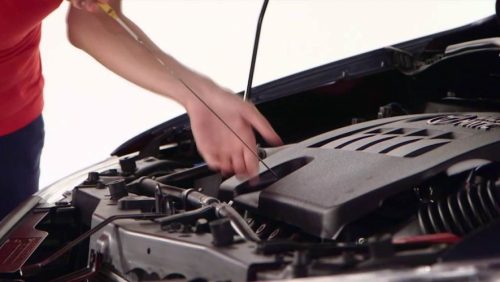
First, park your car on a flat surface and wait for the engine to cool down. This is important to ensure uniform oil levels throughout the engine, and that the oil does not expand due to heat generated by the engine leading to an inaccurate reading.
Open the hood, and get a clean piece of cloth. You will need to identify the car gauge. Look at number 2 in the picture above – a long, thin piece of metal that usually has a yellow or orange plastic handle. It’s usually fairly easy to access, and is located near the engine.
Gently pull the dipstick out, being careful not to drip oil onto the engine. Wipe it with the cloth, put it back in place and then pull it out again.
The scale has minimum and maximum marks at its tip. A healthy engine will have the oil level on the dipstick at a point between the two marks – preferably towards the maximum.
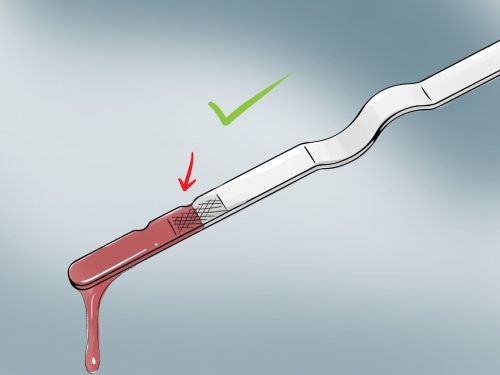
Check the color of the oil. It should be golden or light brown – if it is dark or black, this means it is old and the oil must be changed.
Once you have checked the oil, put the dipstick back in place and ensure it is back in force in the engine.
Explanation of points No. 3 and 8
See the picture above
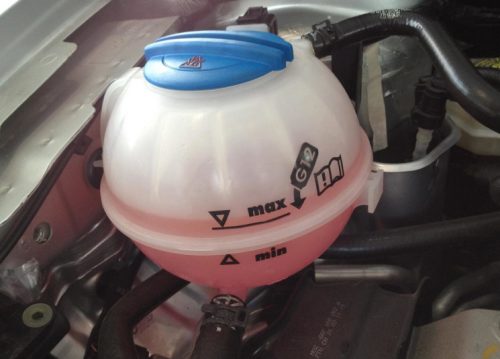
The radiator cools the engine by using water and coolant (called glycol antifreeze).
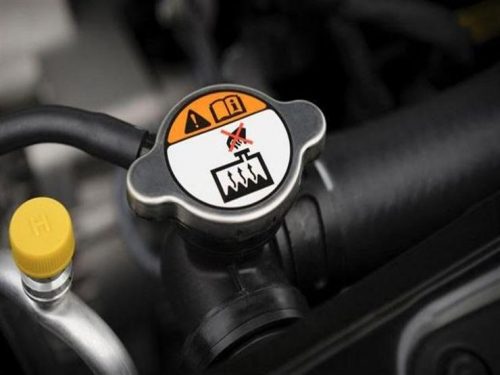
Always use a mixture of water and glycol liquid in equal proportions to fill the car’s cooling system.
Use plain water only in case of emergency, as most modern cars have aluminum cylinder heads that require corrosion-preventing materials.
Never add glycol fluid to a hot engine. If you need more fluid, wait until the engine cools to avoid burning or cracking the engine block.
To check the water level in the cooling system and add more if necessary, do the following:
If your car has a coolant recovery system (a plastic side container (see No. 3 in the picture above) connected to the radiator that contains an additional amount of fluid)
There is no need to open the radiator cap, just check to make sure that the fluid reaches the fullness limit indicated on the side of the container.
If this is not the case, add the mixture of water and glycol in equal proportions to that container.
The car’s water container is pressurized and has its own radiator cap instead of the usual cap.
Do not open these reservoirs when the engine is hot, otherwise the fluid will flow out of it with great force and may cause burns and serious consequences.
If your car does not have an additional container for coolant water. You need to open the radiator cap, look through it, and add fluid if necessary.
Never try to open the radiator cap when the engine is hot, as the rising steam can cause severe burns.
Wait until it cools completely so you can easily open the lid.
To open the lid, place a piece of cloth over the lid and turn it counterclockwise one turn, very slowly. This allows the pressure to be reduced.
If you see liquid or a large amount of steam rising, reclose the cap and wait until the engine cools completely.
Explanation of point number 4
See the picture above
The wiper water container contains water that is blue in color with glycol, and glycol is an antifreeze. It is placed and mixed with water to prevent it from freezing in winter and extreme cold.
You can simply fill water through a bottle, the cover of which is usually blue or black, and this is an example
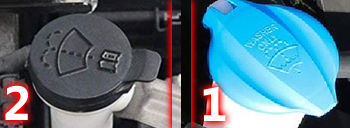 As we can see on the covers, there is a drawing indicating the purpose of this water container. It is clear that it is for front and rear window water, which is pumped using a hand or a stick that moves up or down next to the car’s steering wheel. You can simply open the container and fill the glass water with it.
As we can see on the covers, there is a drawing indicating the purpose of this water container. It is clear that it is for front and rear window water, which is pumped using a hand or a stick that moves up or down next to the car’s steering wheel. You can simply open the container and fill the glass water with it.
You can buy bottles or gallons of water from any place that sells car tools, and these containers look like this
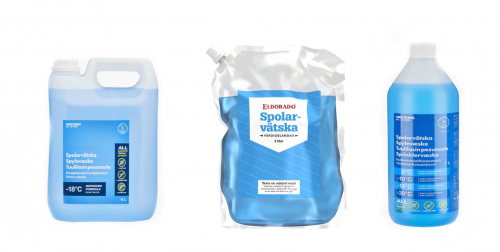
Spolarvätska
When there is a shortage of water in the car, you will find a small light on the dashboard of the car alerting you that the water has run out and you must fill the water in the container designated for that.
Explanation of point number 5
See the picture above
The radiator fan is considered one of the important parts of the car, which must not be exposed to breakdowns. Do not drive the car with the fan broken. The function of the fan is to provide air to cool the radiator and thus the water inside the radiator. Without the fan, the car’s temperature will rise, leading to many problems in the car’s engine.
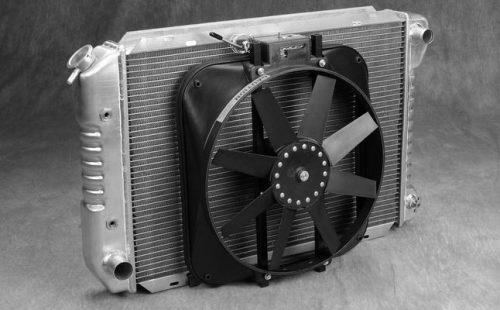
The car’s normal temperature indicator should be in the middle, like the following picture
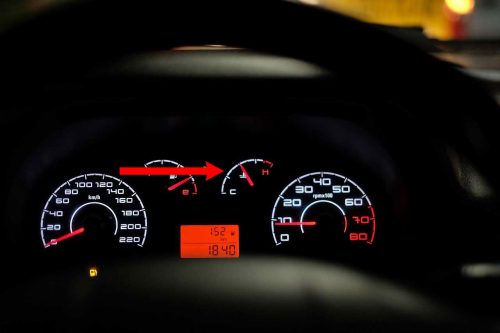
If it is more than that, this means that the car’s temperature is rising, and the problem must be examined and solved so that it does not get worse or cause a major problem with the engine
Explanation of point number 6
See the picture above
The brake fluid container looks like this. Note the drawing or symbol on the container box
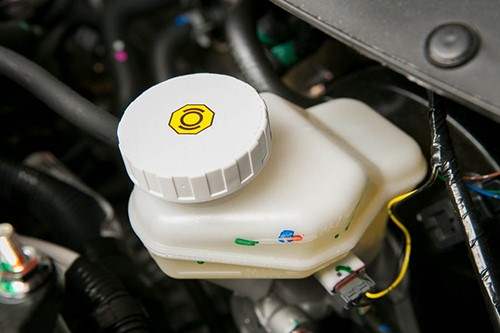
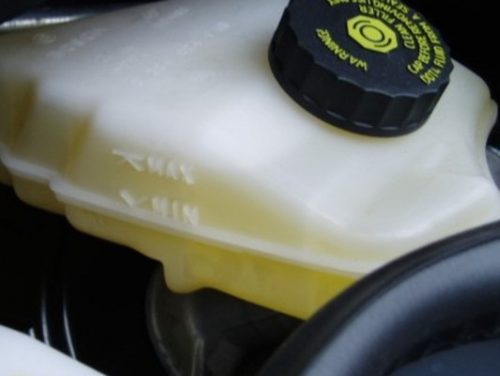
Signs of a defect in the car’s brake system
Illuminating the brake light on the car dashboard while driving and without applying the handbrake or stepping on the regular brakes
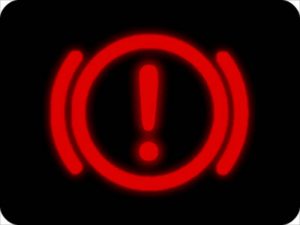
One of the signs that indicate damage to the brake system inside the car is the illumination of the brake indicator located on the instrument panel in front of the car driver. When the brake light that alerts on the front panel of the car comes on, this confirms that there is a defect in the brake system inside the car, and therefore it is necessary to perform maintenance quickly. You should not drive the car when this problem appears.
Low brake pedal level in the car
One of the signs that indicate damage to the brake system inside the car is a drop in the level of the brake pedal in the car. This is a sign that means that you will feel that the brake pedal is not at the same level as the accelerator pedal, and this indicates that the brakes need maintenance, and here you must go to the nearest car maintenance center. In order to avoid exposure to risks.
There is stiffness when pressing the brake pedal
The hardness or hardening of the brake pedal is considered one of the most prominent signs that indicate damage to the brake system inside the car. When you press your foot on the pedal, you will feel that it is more solid than before, and in that case you will find yourself needing to press hard until the car responds and stops. In this case, you must go quickly to a maintenance center in order to overcome this malfunction and replace the damaged part quickly, in order to avoid exposure to risks while driving the car on the road.
Hearing a squeaking sound while pressing the brake pedal
One of the signs that indicate damage to the brake system inside the car is hearing a squeaking sound while pressing the car brakes. This defect may lead to the car swerving from driving at high speed, and this indicates damage to the brake system, and the car driver must quickly go to the A specialized maintenance center, to find the cause of the malfunction and repair it, to avoid exposure to more brake malfunctions.
Braking speed when pressing the brake pedal
When a car’s brakes are in poor condition, their sensitivity usually becomes very sensitive, as they work strongly while gently pressing the brake pedal.
There is vibration in the car while pressing the brakes
When you press the brake pedal hard, you will feel a strong vibration or shudder in the car.
Even if you suspect that the brakes are not working as well as before, you should not risk continuing to drive the car without checking the brakes to ensure that there is no problem.
In the event of brake failure, lack of brake fluid, or weakness, you must transport the car with a crane to the maintenance shop, and you do not have the right to drive the car with the manual brakes, even if they are working well.
Explanation of point number 7
See the picture above
car battery
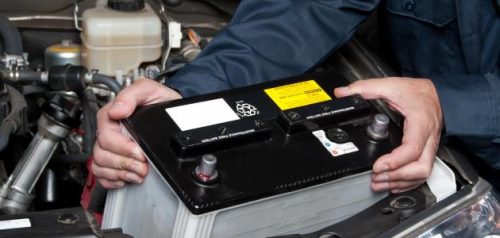
The battery is one of the most important parts of the car. It is the part responsible for supplying the car engine with sufficient current to manage it and start the car, and supplying current to the lamps while the engine is stopped or running by converting chemical energy into electrical energy and converting and storing electrical energy into chemical energy during charging.
Types of batteries
Firstly: Liquid batteries
The liquid battery consists of a number of plates, and each plate contains two electrodes of lead and lead oxide, one negative and the other positive, and all of them are immersed in a concentrated sulfuric solution and distilled water.
The liquid battery has a default lifespan of two and a half years, and this period includes periodic maintenance to maintain its efficiency, such as refilling the tanks with distilled water, and recharging them when empty.
Battery operation produces sulfur fumes that cause damage to some parts of the engine mount and chassis.
Liquid batteries are cheaper than dry batteries.
Secondly: Dry batteries
This type of battery is metaphorically called “dry battery”, as it also contains sulfur liquids, but it is sealed and does not require regular maintenance like a regular battery.
The dry battery has a lifespan of about five years, and requires minimal maintenance.
The prices of dry batteries are 25 to 30% higher than the prices of their liquid counterparts.
A dry battery does not emit burning sulfur fumes or exhaust.
If this warning light comes on in the car dashboard

This means that the battery is not charging sufficiently or there is a malfunction in the battery charging
The problem must be checked as soon as possible
Explanation of point number 9
See the picture above
Picture of the filter location
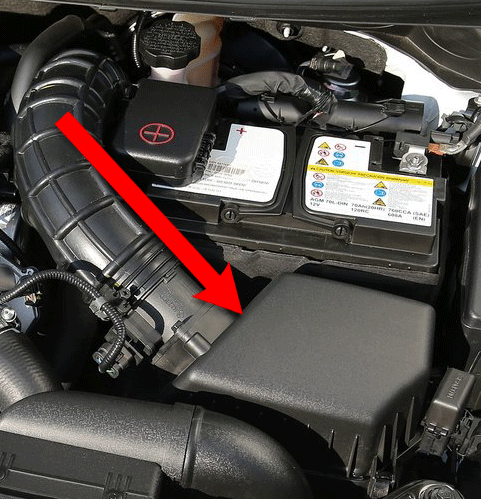 A picture of the shape of the filter. The shapes of filters differ from one car to another
A picture of the shape of the filter. The shapes of filters differ from one car to another
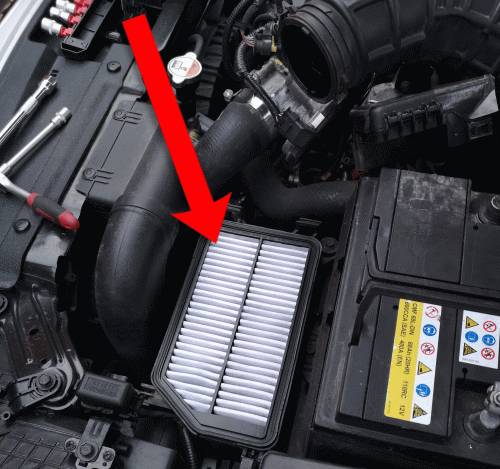 The air filter captures dirt, insects, water, etc. before they can reach the engine. The filter is protected inside a plastic box in order to better protect the engine from pollutants
The air filter captures dirt, insects, water, etc. before they can reach the engine. The filter is protected inside a plastic box in order to better protect the engine from pollutants
The entry of dirt and other things into the engine causes corrosion.
It is noteworthy that there are many elements inside the car that can be delayed in replacing, but the air filter and oil cannot be delayed in replacing.
You must visit the nearest maintenance center to have them checked or replaced if they are defective
Here we must mention that an inefficient air filter may also cause a significant increase in fuel consumption, as malfunction or damage to the filter makes the combustion process in the engine difficult and thus causes excessive fuel consumption.
